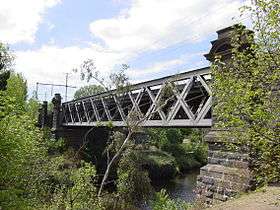George Cornwell
George Cornwell was a British railway engineer and building contractor working in Melbourne, Victoria, Australia in the second half of the nineteenth century. Among his prominent works, were the Hawthorn Railway Bridge built in 1861, with a span of about 60 metres (200 ft), being one of the last major items of permanent way to be completed on the fledgling Melbourne and Suburban Railway. Under the name 'George Cornwell and Co.' Cornwell had previously been involved as contractor in many other major construction works including the Melbourne Grammar School, the Model School, Coppin's Haymarket Theatre, the Sunbury railway goods shed and other Melbourne and Suburban Railway works.[1] Subsequently, he was a contractor on Parliament House, Albert Park Station, Jack's Magazine[2] and the Wallaby Creek water supply.

George Cornwell | |
|---|---|
| Born | c. 1840 England, UK |
| Died | c. 1900 Melbourne, Victoria, Australia |
| Nationality | British |
| Occupation | Engineer |
| Spouse(s) | Jemima Ridpath |
| Engineering career | |
| Discipline | engineer |
| Projects | Melbourne Grammar School, Hawthorn Railway Bridge, Jack's Magazine, Melbourne and Suburban Railway Victoria |
His work also extended to New South Wales, where he won the construction contract for the Wagga Wagga to Albury section of the Great Southern Railway on 14 February 1878, in partnership with F Mixner.[3]
Family and connections
Cornwell married in 1850 Jemima Ridpath. The family was wealthy and well connected. His eldest daughter Alice Ann Cornwell was born in 1852 and she married and then left John Whiteman MLA. She became independently wealthy due to investing in mines. She went to England and bought The Sunday Times newspaper. His youngest daughter Kathleen Clarice Louise Cornwell (1872–1954) was a prolific writer first married to the music critic Herman Klein, and her daughter, Denise Robins, and her granddaughter, Patricia Robins, also became popular novelists. While another daughter Alice Anne Cornwell, married the well-known politician and 'very old colonist', John Whiteman.[4]
Cornwell, however, was also prone to arguments and litigation, having been convicted of assaulting 65-year-old Member of the Legislative Assembly McColl.[5]
References
- "LAST NIGHT'S GAZETTE". The Argus. Melbourne. 28 May 1859. p. 5. Retrieved 29 May 2012 – via National Library of Australia.
- "Jack's Magazine, Victorian Heritage Register (VHR) Number H1154, Heritage Overlay HO45". Victorian Heritage Database. Heritage Victoria.
- Culcairn Railway Precinct – NSW Heritage Branch Website – Online
- "The Argus". The Argus. Melbourne. 3 October 1892. p. 4. Retrieved 8 September 2011 – via National Library of Australia.
- "ECHOES OF MELBOURNE". Launceston Examiner. Tas. 19 November 1883. p. 3. Retrieved 8 September 2011 – via National Library of Australia.